Physical Address
4 Elgon Terrace, Kololo, Kampala, Uganda
Physical Address
4 Elgon Terrace, Kololo, Kampala, Uganda

Africa recorded a solid 7% year-on-year smartphone shipment growth in the second quarter of 2025, reaching 19.2 million units sold, according to Canalys (now part of Omdia). Even as the global market faces headwinds, Africa is emerging among the strongest markets globally.
Several factors helped push this growth. In markets like Egypt, Nigeria, and South Africa, easing inflation has improved consumer purchasing power. Currency stabilization in some countries also helped. More importantly, 5G smartphone shipments in South Africa jumped 63% due to broader network penetration, operator partnerships, and device financing options.
Demand for ultra-low-cost phones (sub-US$100) was also a big factor. These models surged 38% in Q2, offering affordable access to internet and mobile-first services for many.
Not all regions are benefiting equally. Algeria and Morocco saw declines (27% and 7% respectively) largely due to weak demand and stricter import restrictions. Smaller markets still face heavy price sensitivity and lack of financing schemes, which limits how many people can upgrade from feature phones.
Canalys forecasts Africa’s smartphone shipments will keep growing — at a compound annual growth rate of about 2.1% from 2025 through 2029. Continued growth hinges on more affordable device options, localized manufacturing, and stronger partnerships between device makers and mobile network operators.
The growth in Africa’s smartphone market shows that it’s not just about getting 5G networks built—it’s about making devices affordable, improving access, and solving structural issues. If device makers, operators, and governments align, Africa could lead one of the world’s fastest mobile device markets in the coming years.